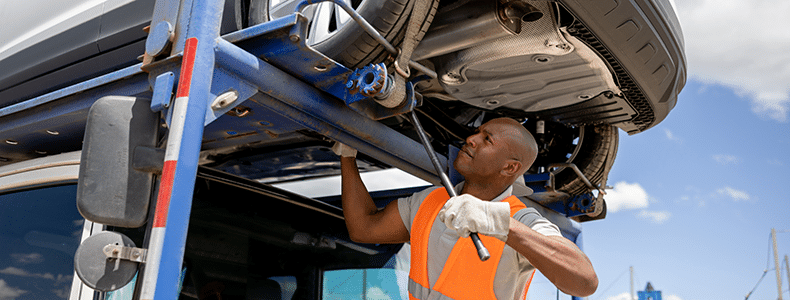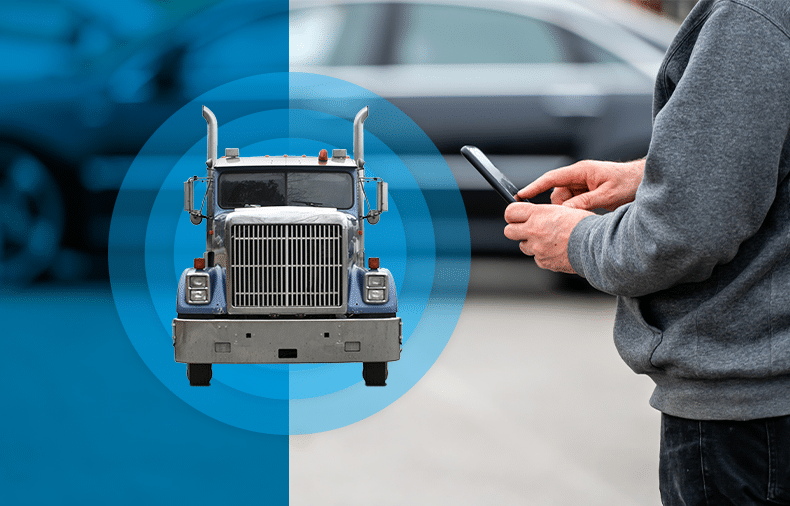Transporting your vehicle can feel overwhelming, but choosing the right auto transport carrier can make all the difference. With a reliable shipping service provider at your side, you’ll have the confidence and peace of mind of knowing that your car, truck, or motorcycle will arrive safely and on time.
Even though finding a carrier might seem daunting, the good news is that researching companies thoroughly and evaluating a few essential criteria can help you make the right choice. In this blog, we’ll explore the key factors to consider when selecting a carrier. Assessing companies in these areas will help prevent potential issues and ensure a smooth transport process.
Whether you need to relocate cross-country or ship a classic car to a collector, we’ve got you covered. Here’s how to choose the right carrier to ship your vehicle stress-free.
DON’T UNDERESTIMATE REPUTATION AND REVIEWS
A carrier’s reputation and reviews from past customers can make or break your vehicle shipping experience. Do in-depth research before trusting anyone with your vehicle.
THE IMPORTANCE OF RESEARCHING A CARRIER’S REPUTATION
A carrier’s reputation gives insight into their level of service, integrity, and professionalism over time, so you’ll want to be wary of newer companies with limited history. While everyone has to start somewhere, long-tenured experience is invaluable in vehicle logistics. Alarm bells should go off for excessive complaints or signs of dodgy business practices.
Specific red flags include:
- Pattern of damage claims due to improper securing methods.
- Numerous late pickup or delivery reports.
- Slow follow-up and reimbursement on claims.
- Lack of communication with customers.
Picture this: A potential carrier offered an impressively low quote. However, after you dig deeper, you notice that past customers reported damage due to improperly secured vehicles, late pickup, damaged RVs, and forgotten reimbursement promises. With so many red flags for dishonesty, the risk isn’t worth the initial savings.

HOW TO FIND AND INTERPRET REVIEWS
Evaluate recency, credibility, realism, and relevance for your situation. A classic car has vastly different needs than a family SUV. Analyze complaints: How were they handled? Does the company actively make things right? No company is 100% flawless, but the ethical resolution of problems separates quality providers from the rest.
LICENSING AND INSURANCE: DON’T LEAVE ROOM FOR ERROR
When your vehicle’s protection is on the line, you’ll want an authorized, comprehensively insured transport company managing the process. Use licensing and policy coverage details to filter uncertified options.
Want added peace of mind? Consider purchasing a uShip Protection Plan.
REGULATORY REQUIREMENTS
Legally operating vehicle transport companies must have proper licensing from the FMCSA (Federal Motor Carrier Safety Administration). This governs safety protocols, operating standards, vehicle inspections, and driver fitness.
This number should be displayed on their uShip profile, but you can ask providers outright for their MC (Motor Carrier) license number if it’s not listed. For example, American Auto Transport holds an active MC #652349, classifying them for vehicle transport authorization. Plug the number into the FMCSA’s online system to validate operating authority and review safety statistics.
A higher “Unsafe Driving” percentage flags repeated moving violations, which can translate to significant liability risks with your vehicle in tow. Companies without any MC number raise suspicion about illegal transport operations.
UNDERSTANDING INSURANCE COVERAGE
Standard cargo insurance often exempts expensive vehicles like RVs or neglects key areas, leaving you vulnerable. Make sure providers carry specialized auto transport insurance like:
- Auto liability coverage for damages/injuries.
- Cargo legal liability as financial protection for vehicles.
- Contingent cargo for delays and wrecks.
- Storage coverage during terminal loading.
For example, some auto transport companies tout $1 million in contingent cargo insurance, buffering client assets even from freak accidents like a terminal fire. Go beyond buzzwords and verify coverage amounts, exclusions, and claim procedure clarity from reps.
Scrimping on licensing diligence or insurance protections could risk your most valuable assets, but doing homework here helps steer toward the safest options.
For total peace of mind, consider purchasing a uShip Protection Plan at checkout.
VERIFYING EXPERIENCE AND EXPERTISE
When hiring a vehicle transport service provider, you want a carrier with years of experience shipping cars, trucks, RVs, and other types of vehicles. An experienced carrier will know how to properly handle your vehicle and avoid common issues that new companies make.
For example, a newer carrier founded a few months ago may not strap vehicles down correctly inside transport trucks. This could lead to complaints about scratches, dents, or other damage from vehicles shifting during transit. Look for well-established companies in business for 4+ years to minimize rookie risks.
SPECIAL VEHICLES NEED SPECIAL CARE
Some vehicles require extra special care, like antique cars, high-end sports cars, RVs, etc. Fortunately, experienced carriers have extensive experience shipping specialty vehicles. As a result, they understand precisely what to do when handling valuable cars and RVs.
For instance, a company lacking expertise with RVs may improperly distribute weight across the trailer bed. This creates unsafe towing conditions, risking accidents and equipment damage. When your vehicle is rare or expensive, find a carrier with proven experience handling those specialty types.
Potential red flags include:
- No specialty equipment like soft ties for vintage paint jobs.
- No experience transporting wide/heavy vehicles.
- Damage claims related to improper securing methods.
CHECKING COST AND PAYMENT TERMS FOR AN AUTO TRANSPORT CARRIER
When budgeting for an auto transport carrier, cost considerations go far beyond the initial quote. Carefully understanding how pricing factors influence your final bill helps ensure accurate budgeting.
Shipping rates can fluctuate widely based on aspects like travel distance, vehicle type, and convenience add-ons. Additional costs may be added for fuel surcharges, terminal charges, and loading fees on top of base pricing. Comparing estimates requires an apples-to-apples understanding of strictly which services are provided for a quote.
Here are some potential red flags to watch out for when reviewing auto transport quotes and payment policies:
Quotes & Pricing
- Extremely low quotes compared to other estimates: This could signal shady business practices or bait-and-switch tactics.
- Avoiding specifics on add-on fees: Vague language like “plus terminal charges” leaves wiggle room to tack on surprises.
- Mandatory gratuity fees: Tips for good service are optional, not a guarantee.
Reputable carriers adhere to legal and ethical guidelines protecting client interests regarding cancellations, payment collection, and reimbursements. Unprofessional operations may charge unusually high deposits, use pressure tactics for upfront payment, or craft tricky compensation rules skewed fully toward the company. Know what to look for before sending valuable vehicle collateral to the 8-lane highway in the sky.
SERVICE OPTIONS: UNDERSTANDING YOUR CHOICES
Carriers offer a range of service methods to meet different needs and budgets. Comparing open vs. enclosed shipping and door-to-door vs. terminal delivery enables informed decisions.
OPEN VS. ENCLOSED TRANSPORT
Open auto transport utilizes uncovered multi-car trailer equipment. This budget-friendly option works well for daily drivers and hardy vehicles but exposes vintage, rare, or high-end vehicles to road debris and weather.
Meanwhile, enclosed trailers offer a secure, climate-controlled interior to prevent paint chips and maintain a consistent environment.
Red flags: Avoid carriers that charge luxury-level enclosed pricing but deliver via open transport. Reputable companies clearly define equipment types in formal quotes.
DOOR-TO-DOOR VS. TERMINAL SHIPPING
For convenience, some auto transport carriers offer door-to-door vehicle pickup and delivery from your home or office. Others utilize terminal shipping, requiring customers to drop off and pick up vehicles at designated transit centers.
While terminal transport saves costs, the customer shoulders responsibility for local transit before/after the central transport leg. Evaluate time costs and local access when choosing.
Red flags: Door-to-door promises that transform into terminal delivery upon contract locking. Clear communication is critical here.
Get clarity on exact services upfront when selecting transport options, understanding choices, and watching for shifty service bait-and-switches.
TRANSPORTATION TIME: FACTORS TO CONSIDER
Transport timing involves more than the transit duration from point A to point B. It’s essential to carefully evaluate the time estimates and factors impacting schedules for realistic planning.
ESTIMATING PICKUP AND DELIVERY WINDOWS
Carriers should provide reasonable upcoming availability windows at the initial quote stage, outlining how soon they can dispatch drivers for pickup. Lengthier wait times extending 2+ weeks could signal capacity issues.
For delivery timeframes, a quality auto transport carrier factors the vehicle type, distance, seasonality, and multi-load routing logistics into their estimate. For example, basic sedans may ship cross-country in 5-7 days during temperate spring months, but that estimate may balloon to 10-14 days for a specialty car during harsh winter road conditions.
Ask timing estimate questions upfront to set expectations, budget rental vehicles if needed, and plan your move/event details accordingly around the transport.
FACTORS AFFECTING TRANSPORTATION TIME
Mechanical issues, traffic delays, weather, and multi-vehicle routing play roles in timely pickup and deliveries. Quality auto carriers build fairly conservative buffers into time estimates to absorb these hiccups.
However, the line between reasonable delays and chronic lateness varies by company. Check reviews for frequent complaints of extreme tardiness exceeding 5+ days past estimates. This signals potential unreliability.
Also, clarify compensation policies for delays under the carrier’s control. Reputable carriers offset customer inconveniences like extra rental car costs if they drop the ball. Get guarantees in writing.
GEOGRAPHIC COVERAGE: DOMESTIC VS. INTERNATIONAL SHIPPING
Vehicle transport geography introduces major process differentiators. Domestically, the U.S. market features advanced infrastructure, making state-to-state shipping fairly straightforward. Internationally, overseas shipping layers burdensome customs, import duties, and maritime transit that warrant vetting.
REMOTE LOCATION CONSIDERATIONS
Transporting to or from remote areas like Alaska, Hawaii, and country backroads poses logistical hurdles like:
- Limited carrier coverage lacking infrastructure access.
- Ferries, borders, and seasonal roads hampering access.
- Difficult last-mile delivery coordination.
Vet auto transport carrier route maps specifically for less-traveled regions. Multi-mode carriers with specialized equipment for harsh terrain provide savvy solutions but expect pricing premiums and delivery lags. Clarify everything for far-flung transport.

VEHICLE PREPARATION: READY FOR THE JOURNEY
Properly preparing your car, motorcycle, or RV helps streamline loading and safeguards against damage risks in transit. Follow critical steps before your vehicle ships out.
PREPARING YOUR VEHICLE FOR TRANSPORT
- Check fluid levels and baseline vehicle condition in case of claims.
- Disable alarms and GPS units that could drain the battery.
- Remove external racks, low-hanging spoilers, etc., that could catch.
- Ensure tires are fully inflated for easier mounting/rolling.
- Empty the vehicle of personal belongings and other cargo.
Follow all instructions from the transport company about gas tank levels, turning off parking brakes, converting convertible tops, etc. Attention to detail prevents issues.
REQUIRED DOCUMENTATION AND INSPECTIONS
To verify vehicle condition and ownership before accepting custody, carriers will inspect the following, along with any additional paperwork:
- Registration confirming ownership details.
- Insurance certificates in case of incidents
- Photo ID for security protections.
- Condition report noting existing wear and tear.
The inspector documents minute details like paint scrapes, upholstery tears, windshield chips, etc., so clients can’t falsely claim these preexisting defects as new damages.
Use the inspection to capture evidence supporting your interests before release. Review condition reports thoroughly and take photos documenting baseline status from all angles before signing. This provides a backup if disputes arise upon delivery.
COMMUNICATION AND TRACKING: STAYING IN THE LOOP DURING TRANSIT
Transporting a vehicle sparks understandable owner anxiety about asset safety during the journey. Selecting an auto transport carrier that offers proactive communication and vehicle tracking options can help peace of mind.
THE IMPORTANCE OF ONGOING COMMUNICATION
Reputable carriers don’t go dark once your car or motorcycle is loaded. They provide status updates throughout key milestones via phone, email, or fleet tracker links.
From scheduled pickup ETA alerts to departure/border crossing notifications to destination arrival confirmations, professional communications keep customers informed without excessive requests.
Be wary of agents who dodge inquiries or use excuses when pinned down for updates. Unavailable staff managing critical cargo inspires little confidence.
OPTIONS FOR TRACKING YOUR VEHICLE
Many top-tier transport carriers feature real-time GPS tracking, letting customers monitor a vehicle’s location and progress via online links. This technology enables accident response if incidents occur while offering peace of mind on transport status for control freaks.
Security-minded car collectors shipping rare vintage vehicles may even opt for supplemental asset protection, such as radio-frequency trackers inside the car or discrete exterior mount GPS units feeding location data.
When your baby hits the road for a long journey in a stranger’s hands, leveraging all communications and technology at your disposal helps you breathe easier. Seek customer service over lip service.
CUSTOMER SERVICE AND SUPPORT: A REFLECTION OF QUALITY
A transport carrier’s customer service reputation showcases its communication skills, responsiveness, and accountability. Vetting support practices safeguard positive experiences.
ASSESSING THE QUALITY OF AN AUTO TRANSPORT CARRIER
Even among top-rated carriers, customer support levels vary. Conduct due diligence through:
- Calling, emailing, or chatting with questions and monitoring their response time, knowledge depth, and professionalism.
- Researching reviews highlighting great or terrible service experiences.
- Noting if representatives proactively contact customers vs. placing the burden solely on you.
- Checking if the company has in-house support staff or farms tasks out to third parties.
Getting courteous, prompt, and empowered support provides confidence in a smooth process. On the other hand, disorganization and unaccountability should set off alarm bells.
AVAILABILITY OF SUPPORT THROUGHOUT THE PROCESS
The highest-quality auto transport carriers offer customer assistance before, during, and after your vehicle ships. Here’s what you can expect from a top-notch carrier:
Upfront guidance tailoring the best transport solutions to your situation and budget.
Real-time status updates during the transit journey.
Follow-up care to resolve any post-delivery issues like suggestions for cleaning, damage repairs, reimbursement facilitation, etc.
CHOOSE AN AUTO TRANSPORT CARRIER YOU CAN TRUST
Transporting a vehicle between destinations can be stressful and potentially damaging. That’s why choosing the right auto transport carrier is a significant decision that requires thorough diligence.
Whether you’re shipping a vintage car to a new city or relocating a motorcycle cross-country, it’s essential to study these factors to choose the right auto transport carrier for your shipping needs. Don’t settle for anything less than a 5-star provider to entrust your valuable cars, motorcycles, RVs, and other vehicles into the care of.
When reliability and peace of mind matter most, uShip delivers. With our robust platform connecting shippers to a vast network of trusted carriers, we ensure your vehicle reaches its destination securely and efficiently. Say goodbye to uncertainties and hello to seamless shipping experiences with uShip.
FREQUENTLY ASKED QUESTIONS (FAQS)
How do I choose the best vehicle carrier?
Conduct thorough research on factors like licensing, insurance, reputation, customer service, expertise with your vehicle type, pricing, and delivery guarantees. Vet a few top contenders through customer reviews before selecting the most qualified carrier.
What is the difference between open and enclosed transport?
Open carriers use uncovered multi-car trailer equipment exposed to weather and road debris. Enclosed trailers offer a secure, climate-controlled interior to prevent paint chips and damage, best for rare, vintage, and high-end vehicles.
How much does it cost to ship a car?
Average costs range widely based on distance, vehicle type, transport method, and seasonal demand. On average, prices can range from a few hundred to a few thousand dollars.
How long does it take to transport a vehicle?
Door-to-door U.S. transport averages 5-14 days for continental distances. Factors like weather, breakdowns, and multi-load routing influence timeliness. Overseas shipping extends to 3-6 weeks.
What do I need to do to prepare my car for transport?
Check fluid levels, turn off battery-draining devices, remove external racks/spoilers, inflate tires, empty the vehicle, and follow all instructions from the auto transport carrier before release.
Is insurance coverage provided during vehicle transportation?
Reputable carriers carry auto liability, cargo legal liability, contingent cargo, and storage coverage, protecting vehicles in case of damages, delays, wrecks, or terminal incidents. Verify policy details before moving forward. Or purchase a uShip Protection Plan for total peace of mind.
Can I ship my car internationally?
Yes, it’s possible to ship your car internationally. Overseas shipping requires customs expertise, import/export administration, and specialty international equipment drastically different from domestic services. As a result, international shipping typically comes with pricing premiums.
How can I track my vehicle during transportation?
Many top carriers offer real-time GPS tracking links to monitor vehicle locations and status throughout your shipment’s journey for security. You can also communicate with your auto transport carrier directly for the most up to date info.
What are the signs of a reliable auto transport carrier?
Some positive signs include 5+ years in business, FMCSA licensing, sterling Better Business Bureau reputation, 5-star customer reviews, professional communications, guaranteed delivery windows, and comprehensive auto insurance policies.
How do I find reviews for car shipping carriers?
uShip offers a comprehensive platform where you can access reviews and ratings from real customers who have used various carriers.



